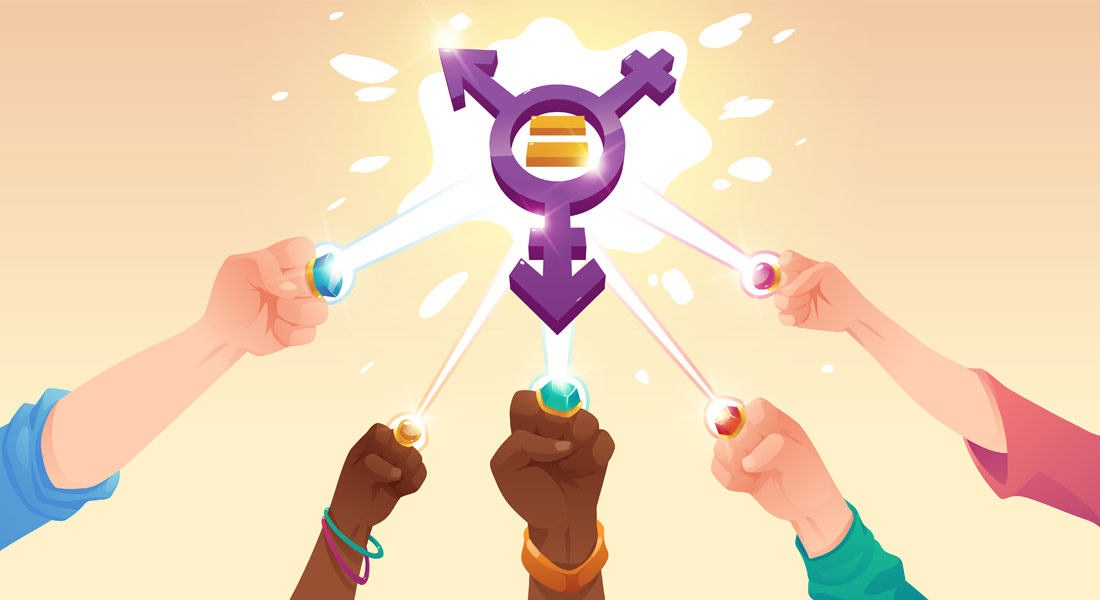Sex, Gender, Diversity
Karin Grasenick, Julia Trattnig | 29 September 2021
Sex and gender are often differentiated as binary categories, however, the idea of two sexes is far too simplistic.
For this reason, feminist theory often uses the distinction of “sex” and “gender”: The underlying assumption is that sex differences are determined by biological factors (chromosomes, hormones, body composition, etc.), while gender considers the interplay with socio-economic and psychological factors (i.e. the effect of gender norms and roles) and further co-variables that might be influential.
Sex refers to the biological differentiation between “male” and “female” and is determined by chromosomes, genes, hormones and anatomy.
The concept of “intersex” refers to a variety of conditions, whereby a person’s combination of sexual, anatomical, and physiological traits does not fit the typical definition of male and female (Ainsworth, 2015; ISNA, 2015).
The term gender refers to the social construction of women, men and non-binary persons.
Societies and cultures associate competences, behaviours and attitudes with a person’s biological sex, and related expectations and ascribed roles might lead to differences in persons’ paths through life, for instance, by influencing whether and how occupational choices and achievements are recognised.
However, some theoreticians (among others Judith Butler) have criticised this distinction as both terms are understood as culturally constituted categories. From this perspective, gender is understood as “doing”, as performative act (Butler, 1990). This conception has also been transferred to neuroscience, as Kaiser notes: “Sex/Gender” has been used to raise awareness that both categories are socially constructed, and both effect the brain in a complex interplay (Kaiser, 2012).
The term diversity comprises the manifold traits and characteristics of human subjects and their differences based on various dimensions. Some of these traits are inherent (e.g. sex, ethnicity, race, sexual orientation, body composition, physiology, age), some are ascribed or acquired (e.g. gender, skills, knowledge, technological literacy) and others are context related (e.g. different mobility capacities in private and working context, social and economic background, working and living environment, lifestyle) (Gardenswartz/Rowe, 2003).
In the context of neuroscience, cognitive diversity, touching the fields of neurodiversity, neurogender and neurosexism (Rippon, 2016), plays an important role. It means that everyone has different cognitive skills, which result in innovation and benefits if individuals with these different skills work together (Page, 2007).
The European Union prohibits discrimination on the grounds of sex, race, colour, ethnic or social origin, genetic features, language, religion, belief, political or any other opinion, membership of a national minority, property, birth, disability, age or sexual orientation (EU Agency for Fundamental Rights, 2021/2009).
References
Ainsworth, Claire (2015): Sex redefined. In: Nature 518, p. 288–291. DOI: https://doi.org/10.1038/518288a
Butler, Judith (1990): Gender Trouble. Feminism and the Subversion of Identity. New York/London: Routledge.
European Union Agency for Fundamental Rights (2021/2009): Charter of Fundamental Rights of the European Union. URL: https://fra.europa.eu/en/eu-charter [11.08.2021]
Gardenswartz & Rowe (2003): Diverse teams at work. URL: https://www.gardenswartzrowe.com/why-g-r [11.08.2021]
Gendered Innovations: “Race & Ethnicity”. URL: https://genderedinnovations.stanford.edu/terms/race.html [11.08.2021]
Intersex Society of North America (ISNA): “What is intersex?”. URL: http://www.isna.org/ [11.08.2021]
Kaiser, Annelies (2012) Re-Conceptualizing “Sex and “Gender” in the Human Brain. In: Zeitschrift für Psychologie, 220(2), 130–136. DOI: https://doi.org/10.1027/2151-2604/a000104
Page, Scott (2007): The Difference: How the Power of Diversity Creates Better Groups, Firms, Schools, and Societies. Oxford: Princeton University Press. DOI: 10.2307/j.ctt7sp9c
Rippon, Gina (2016): “How ‘neurosexism’ is holding back gender equality – and science itself”. In: The Conversation. URL: https://theconversation.com/how-neurosexism-is-holding-back-gender-equality-and-science-itself-67597 [11.08.2021]
WHO (2016): FAQs on health and sexual diversity. URL: https://www.who.int/news-room/q-a-detail/gender-and-health [11.08.2021]

